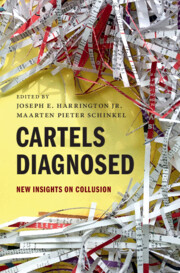Book contents
- Cartels Diagnosed
- Cartels Diagnosed
- Copyright page
- Contents
- Figures
- Tables
- Contributors
- Introduction
- 1 Entry Barriers, Personal Relationships, and Cartel Formation
- 2 “Now You Are Asking for a Real War!”
- 3 Coordinating Fuel Surcharges
- 4 Price Fixing or Fixing Competition?
- 5 The Role of Platforms for Facilitating Anticompetitive Communication
- 6 Collusion with Non-express Communication
- 7 Cartel Instability and Price Wars
- 8 Coordinated Rebate Reductions and Semi-collusion
- 9 Average Bid Auction Format Facilitates Bidding Rings
- 10 The Challenges of Cartelization with Many Products and Ongoing Technological Advancements
- 11 Two Cartels in the Supply Chain
- 12 Is it Collusion or Competition behind Price Parallelism?
- References
10 - The Challenges of Cartelization with Many Products and Ongoing Technological Advancements
Liquid Crystal Displays Worldwide*
Published online by Cambridge University Press: 06 December 2024
- Cartels Diagnosed
- Cartels Diagnosed
- Copyright page
- Contents
- Figures
- Tables
- Contributors
- Introduction
- 1 Entry Barriers, Personal Relationships, and Cartel Formation
- 2 “Now You Are Asking for a Real War!”
- 3 Coordinating Fuel Surcharges
- 4 Price Fixing or Fixing Competition?
- 5 The Role of Platforms for Facilitating Anticompetitive Communication
- 6 Collusion with Non-express Communication
- 7 Cartel Instability and Price Wars
- 8 Coordinated Rebate Reductions and Semi-collusion
- 9 Average Bid Auction Format Facilitates Bidding Rings
- 10 The Challenges of Cartelization with Many Products and Ongoing Technological Advancements
- 11 Two Cartels in the Supply Chain
- 12 Is it Collusion or Competition behind Price Parallelism?
- References
Summary
◦ The case study of the liquid crystal display (LCD) cartel underscores the strong incentives that arise in an oligopoly to limit competition but also the practical difficulties in doing so when there are many products and varieties involved.
◦ The breadth of the cartel is impressive in that it encompassed all uses of LCD panels and did so for at least a decade. It is partly that breadth that posed a challenge for there were hundreds of different products and a dozen manufacturers. Rather than trying to coordinate the prices of the entire product line, the cartel focused only on the highest selling products, and at a degree of aggregation which did not fully take account of quality differences.
◦ The lack of collusion over all products’ prices could result in less effective collusion which the case study finds as the estimated overcharge is no higher than 2 percent. But even a 2 percent overcharge would have resulted in incremental revenues to the conspirators exceeding $3 billion. The takeaway is that even a highly imprecise collusive arrangement can be profitable to firms and harmful to buyers.
- Type
- Chapter
- Information
- Cartels DiagnosedNew Insights on Collusion, pp. 272 - 316Publisher: Cambridge University PressPrint publication year: 2025

